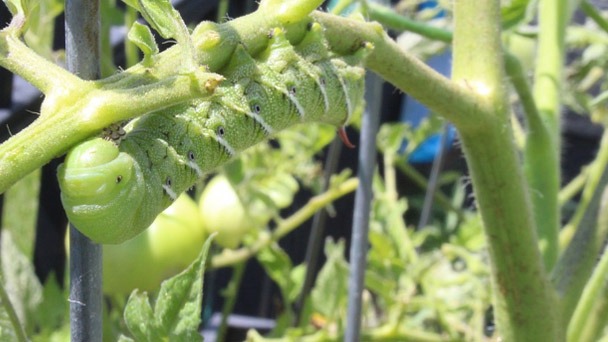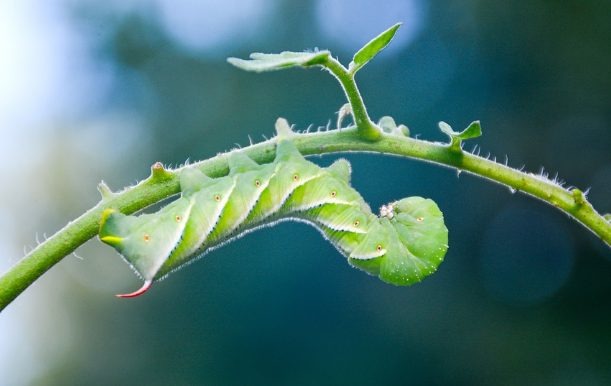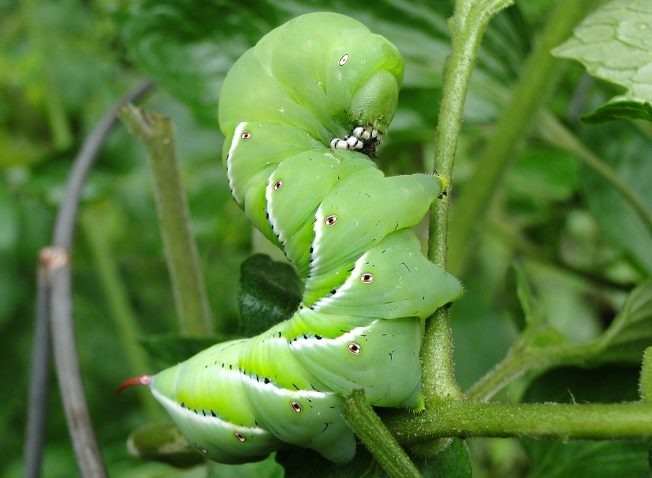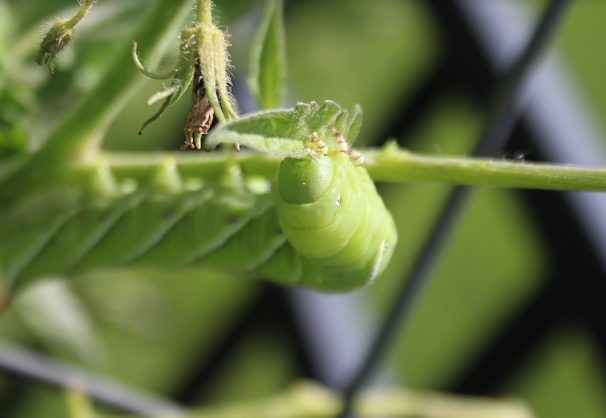The Life Cycle of the Tomato Hornworm - Lifespan & How to Control
Written by Ivy
Jan 09 2023

Tomato hornworms (Manduca quinquemaculata) get their name from the long horn-like tail on the larvae or caterpillar's posterior end. While they do eat tomato plants, they also eat other members of the nightshade (Solanaceae) family, including potatoes, eggplants and capsicums. The larval stage and the adult stage of the tomato hornworm life cycle follow a complete metamorphosis developmental pattern, and they both have entirely different appearances.
Life Cycle of the Tomato Hornworm:
- Eggs
- Caterpillar
- Pupa
- Moths
Tomato Hornworm Identification

Tomato hornworms are sometimes confused with the closely related species, tobacco hornworms (Manduca sexta). The markings on the bodies of these caterpillars are a crucial factor in identifying them. Tobacco hornworms have diagonal white lines and a red horn, while tomato hornworms have yellow or white V-shaped markings with black horns.
The adult moths are often called sphinx moths, five spotted hawkmoths or hummingbird moths. They have a fairly large body, and on either side of their abdomen, there are five sizable orange spots. The adult tobacco hornworm moths have six spots down each side of their abdomen, which are frequently more distinct and vivid orange in color. They otherwise resemble each other very closely.
Tomato Hornworm Life Cycle
Egg, larva or caterpillar, pupa, and adult moth are the four stages of the tomato hornworm life cycle. The tomato hornworm eggs are less than 0.039 inches long and are a pearly pale green to greenish-yellow color. When the caterpillars molt, they start to eat ferociously. As they grow, they begin to get too big for their hard "skin," or exoskeleton, and shed it off to form a new one through a process called molting. The time in between each molting phase is called an instar. Tomato hornworm caterpillars go through five instars before they become pupa.
In a constrained area underground, the pupa grows. The caterpillar's body splits apart and reforms into an adult moth while it pupates. After emerging from their puparium, the moths are nocturnal and fly around, feeding on nectar from flowers and seeking mates. The tomato hornworm life cycle restarts after mating when the female leaves to lay her eggs on a nightshade plant that the larvae enjoy eating.
Tomato Hornworm Eggs
A moth can lay one to five eggs on a single plant. She carefully lays her eggs on the undersides of leaves using an elongated organ on her posterior called an ovipositor. She can produce between 1,000 and 2,000 tomato hornworm eggs in her lifetime.
Tomato Hornworm Caterpillar
Often called tomato caterpillars for short, two or three of these ravenous larvae can demolish all the leaves on an entire plant. They occasionally will eat the fruit as well, depending on how hungry they are. Instead of drilling tiny holes in the fruit as they consume it, they leave large open wounds on the surface. Every now and then, they will transfer to a new plant. In most cases, they won't do so until their fifth instar. Before they grow to a length of three or four inches, the caterpillars eat for three to four weeks.
Tomato Hornworm Pupa
When fully grown, caterpillars fall from the plant to the ground and dig a chamber for their pupation four to six inches beneath the surface of the soil. Two generations of larvae emerge every summer. The first generation of tomato hornworm pupae emerge in the middle of the summer after two weeks of development. The moths of the second generation emerge in the spring after spending the winter as pupae in the soil.
Tomato Hornworm Moths
The moths' wingspan is four to five inches wide. Strong, nimble flyers, these big moths are. They can drink nectar from nocturnal flowers using their long proboscis mouthpiece. The moths play significant pollination roles for many plants, despite the fact that the caterpillars are extremely destructive. The adults have a long lifespan.
Habitat and Diet of Tomato Hornworm
The five-spotted hawk moth's natural habitat is Australia and the United States. It is found all over these two continents. In contrast to the tobacco hornworm, which is more common in the south, five-spotted hawk moths and their larvae are more common in the northern United States.
In the majority of stages of the tomato hornworm life cycle, the tomato plant is preferred. Tobacco, eggplant, potatoes, and peppers are all Solanaceae family members that they may also eat. Jimsonweed, horsenettle, and nightshade are just a few of the weeds tomato hornworms will eat. This is less frequent, though.
As adults, they sip nectar from blooming plants like Oenothera caespitosa, Mirabilis multiflora, and Datura meteloides. Moths are attracted to these plants by their fragrant white blossoms.

How Many Eggs Does a Tomato Hornworm Moth Lay?
It is the adult moth that is laying the eggs, not the worm. She will typically lay her eggs on the underside of the leaves and do so at night. Every time a moth visits a pant, she can lay anywhere between one and five eggs, for a potential total of up to 2,000 eggs.
The first generation of hornworm larvae will appear in late May or early June. The larvae tunnel into your soil to pupate after three weeks of feeding.
The first generation of adults and the second generation of tomato hornworm pupa are visible from early August to early October.
How Fast Do Tomato Hornworms Grow?
In late spring, the adult hornworms begin reproducing. They lay their eggs, which you can see as tiny green spheres.
The development stage, which can last up to four weeks, starts after the eggs hatch, which takes about 6 to 8 days. They continue to graze on your plants from this location.
They burrow underground at the end of the growing season and spend the winter in the pupal stage. In the subsequent year, in June or July, these start to emerge as adults.
Either while they are growing or sleeping, you can get rid of these hornworms from your garden.
How to Prevent Tomato Hornworm in Your Garden
Tomato hornworms, which have already been mentioned, seriously harm plants by eating away at the foliage and, in some cases, eating holes in the fruit. Particularly in the final stages of the tomato hornworm life cycle, these worms are enormous. All this makes it easy to see an infestation. Furthermore, getting rid of them is not too difficult. The simplest and most effective tactic might be to simply pick them off the plants as you find them.
A natural bacterium called Bacillus thuringiensis is frequently used by gardeners to treat severe infestations. By paralyzing the worm's digestive tract, this bacterium prevents them from eating. Similar to insecticidal soap and spinosad, which are both low-risk insecticides, this is. These insecticides are superior to broad-spectrum pesticides like bifenthrin, lambda-cyhalothrin, cyfluthrin, and permethrin since they don't harm other insects.
As an alternative, you could add predatory insects to your garden, such as ladybugs or green lacewings. They eat the eggs and larvae of tomato hornworms. Some wasp species, like paper wasps, use this kind of caterpillar as a food source as well.
This caterpillar has a variety of natural predators. Gardeners may release chickens and other birds nearby to chase them off the plant. Similar to this, a number of parasitic braconid wasp species also attack hornworms. They typically lay their eggs on the hornworms' backs. The wasp larvae will consume the worm when it hatches.

Final Thoughts
If you observe leaves that have been significantly defoliated, eaten blooms, or scars on the fruit's surface, you may have tomato hornworms. Sunscald damage to the fruit is also a possibility because of the decreased leaf cover. To save your crops in this situation, you might need to act quickly. Fortunately, removing tomato hornworms from your garden becomes much simpler if you have a thorough understanding of their life cycle.
Latest Updated
- Benefits of Bugleweed - 7 Science-backed Health Benefits
- Bugleweed Dangers & Side Effects - Is It Poisonous?
- How to Plant Evergreen Trees - What You Should Know
- When to Plant Evergreens - Grow Guide for Evergreen Trees
- 12 Wonderful Evergreen Shrubs for Your Garden
- 12 Popular Evergreen Plants with Pictures for Beginners
- When And How To Prune A Lilac Bush Like a Pro
- How to Grow & Care for Lilac Vine (Hardenbergia Violacea)
- Japanese Lilac Tree (Syringa Reticulata) Care & Propagation Guide
- Shumard Oak Pros and Cons - What to Know
Popular Articles
- Winter maintenance of Antirrhinum Majus
- How to Grow Terminalia Mantaly Tree
- How to Grow and Care for Crossostephium Chinense
- How to grow Antirrhinum Majus in spring
- Peristeria Elata (Dove Orchid) Profile: Info & Care Guide
- Underwatered Snake Plant (Sansevieria Trifasciata) - Signs And How To Fix
- How to Care for Brazilian Jasmine Plant (Mandevilla Sanderi)
- How to Grow & Care for Graptopetalum Purple Delight in Summer
- Rosa Chinensis (China Rose): Plant Growing & Care Tips
- How to Care for Baby Sun Rose (Aptenia Cordifolia)